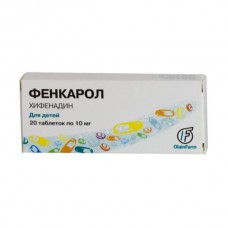Expiration date: 05/2025
The composition and form of issue:
Tablets. 1 tablet contains active substance:
hifenadina hydrochloride 10 mg
excipients: sugar — 25 mg of potato starch and 14.5 mg calcium stearate — 0.5 mg
in a contour acheikova packing 10 PCs. in cardboard pack 1, 2, 3, 4 or 5 blisters.
Tablets. 1 tablet contains active substance:
hifenadina hydrochloride 25 mg
excipients: sugar — 33,5 mg potato starch is 40.5 mg calcium stearate 1 mg
in a contour acheikova packing 10 PCs. in cardboard pack 1, 2, 3, 4 or 5 blisters.
Description pharmaceutical form:
Valium round pill white or almost white, with facet.
Pharmacokinetics:
45% of hifenadina is rapidly absorbed from the intestine and after 30 min found in the tissues of the body. Cmax of the active substance in plasma achieved through 1 h Has a low lipophilicity, poorly crosses the GEB. The highest content of active substances marked in the liver, somewhat lower in the lungs and kidneys, the lowest — in the brain (less than 0.05%, which explains the lack of depressive effect on the Central nervous system). Hifenadin metabolized in the liver. The metabolites are excreted by the kidneys and intestines. From the bowel is neabsorbirovanna of the drug.
Description pharmacological action:
Hifenadin — blocker of H1-histamine receptors prevents the development and facilitates the allergic reactions. Has antiallergic, antiexudative and antipruritic effect, preventing the development of allergic inflammation in the tissue. Weakens the action of histamine and reduces its influence on the permeability of blood vessels (reducing permeability, has anti-edematous effect), it reduces the bronchospastic effect and spazmogennoe effect on smooth muscles of intestines, weakens the hypotensive action of histamine. Hifenadin reduces the content of histamine in the tissues (associated with the ability to activate diaminoxydazu enzyme inactivating histamine). In exchange treatment antihistamine effect of hifenadina is not reduced. It has a moderate antiserotoninova effect, shows a weak m-holinoblokirutuyu activity. Not have a depressive effect on the Central nervous system.
Indications:
- hay fever
- acute and chronic urticaria
- angioedema
- allergic rhinitis
- dermatoses, including eczema, psoriasis, atopic dermatitis, pruritus.
Contraindications:
- individual intolerance to the drug
- pregnancy
- lactation
- children up to age 3 years (for this dosage form)
- deficiency of sucrase/isomaltase, fructose intolerance, glucose/galactose, malabsorbtsija, since LS contains sucrose.
Caution: in diseases of the gastrointestinal tract, liver and kidneys.
Side effects:
Dry mucous membranes of the mouth, nausea, vomiting, drowsiness, allergic reactions, headache.
Drug interactions:
Having a weak m-holinoblokirutmi properties can reduce the motility of the gastrointestinal tract and increase the absorption of slow-absorbing drugs (e.g., indirect anticoagulants — coumarins).
Method of application and dose:
Inside, after eating.
The dosing regimen of the drug coincides with all the indications for use. The dosing of hifenadina can influence the severity of allergic reactions, the sensitivity of the individual patient and the severity of possible side effects.
Adults — 25-50 mg 2-4 times a day. The maximum daily dose is 200 mg. the Duration of treatment is between 10-20 days. If necessary, repeat the treatment.
Children from 3 to 7 years — 10 mg 2 times a day from 7 to 12 years — 10-15 mg 2-3 times a day over 12 years — 1 table. 25 mg 2-3 times a day. The duration of 10-15 days.
Overdose:
Symptoms: dry mucous membranes, headache, vomiting, abdominal pain and other dyspeptic phenomenon.
Treatment: gastric lavage, reception activated carbon, symptomatic therapy. Immediately consult a doctor.
Special instructions:
Use during pregnancy and lactation. Not recommended for use throughout pregnancy. If necessary, use during pregnancy should carefully weigh the ratio of the expected benefit to the mother and the risk to the fetus. If necessary, drug treatment breastfeeding should be stopped.
Mild m-holinoblokirutmi effect allows you to assign hifenadin patients who are contraindicated antihistamines, with m-holinoblokiruta activity.
Effects on ability to drive or to perform work requiring high speed physical and mental reactions. Individuals whose jobs require high concentration and psychomotor speed reactions, should be pre-determined (by the short-term purpose), not whether the drug is sedation.




